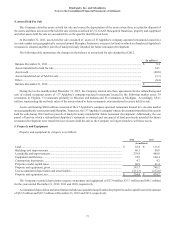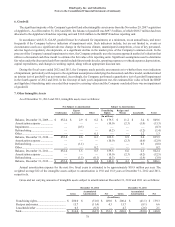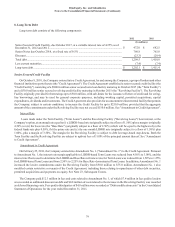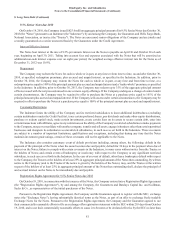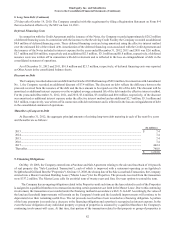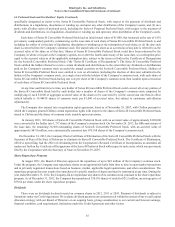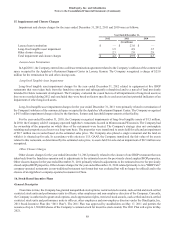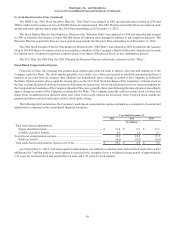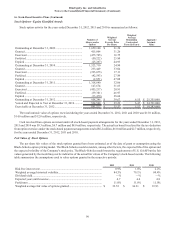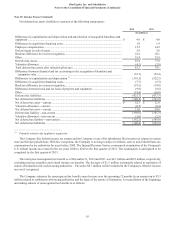IHOP 2012 Annual Report Download - page 103
Download and view the complete annual report
Please find page 103 of the 2012 IHOP annual report below. You can navigate through the pages in the report by either clicking on the pages listed below, or by using the keyword search tool below to find specific information within the annual report.
DineEquity, Inc. and Subsidiaries
Notes to the Consolidated Financial Statements (Continued)
85
11. Fair Value Measurements
U.S. GAAP pertaining to fair value measurements defines fair value as the price that would be received to sell an asset or paid
to transfer a liability in an orderly transaction between market participants at the measurement date (an exit price). U.S. GAAP
establishes a three-tier fair value hierarchy that prioritizes the inputs used in measuring fair value. These tiers include: Level 1,
defined as observable inputs such as quoted prices in active markets; Level 2, defined as inputs other than quoted prices in active
markets that are either directly or indirectly observable; and Level 3, defined as unobservable inputs in which little or no market
data exists; therefore requiring an entity to develop its own assumptions.
The Company does not have a material amount of financial instruments that are required under U.S. GAAP to be measured
on a recurring basis at fair value. None of the Company's non-financial assets or non-financial liabilities is required to be measured
at fair value on a recurring basis. The Company has not elected to use fair value measurement, as provided under U.S. GAAP, for
any assets or liabilities for which fair value measurement is not presently required.
12. Fair Value of Financial Instruments
The Company believes the fair values of cash equivalents, accounts receivable, accounts payable and the current portion of
long-term debt approximate their carrying amounts due to their short duration.
The fair values of non-current financial instruments, determined based on Level 2 inputs, are shown in the following table:
December 31, 2012 December 31, 2011
Carrying
Amount Fair Value Carrying
Amount Fair Value
(In millions)
Long-term debt, less current maturities $ 1,202.1 $ 1,334.2 $ 1,411.4 $ 1,486.2
13. Commitments and Contingencies
Purchase Commitments
In some instances, the Company enters into commitments to purchase advertising and other items. Most of these agreements
are fixed price purchase commitments. At December 31, 2012, the outstanding purchase commitments were $137.5 million, the
majority of which related to advertising.
Lease Guarantees and Contingencies
In connection with the sale of Applebee's restaurants to franchisees and other parties, the Company has, in certain cases,
guaranteed or had potential continuing liability for lease payments. As of December 31, 2012 and 2011, the Company has
outstanding lease guarantees or is contingently liable for approximately $448.5 million and $349.6 million, respectively. This
amount represents the maximum potential liability of future payments under these leases. These leases have been assigned to the
buyers and expire at the end of the respective lease terms, which range from 2013 through 2048. In the event of default, the
indemnity and default clauses in our sale or assignment agreements govern our ability to pursue and recover damages incurred.
No material liabilities have been recorded as of December 31, 2012.
In 2004, Applebee's arranged for a third-party financing company to provide up to $250.0 million to qualified franchisees for
loans to fund development of new restaurants, subject to its approval. The Company provided a limited guarantee of 10% of certain
loans advanced under this program. The Company will be released from its guarantee if certain operating results are met after the
restaurant has been open for at least two years. As of December 31, 2012, there were loans outstanding under this program to one
franchisee for approximately $13.1 million, net of any guarantees from which the Company was released. This program expired
on October 31, 2007; however, the Company's guarantee will remain outstanding until the provisions for release have been satisfied,
as defined in the related agreement.




